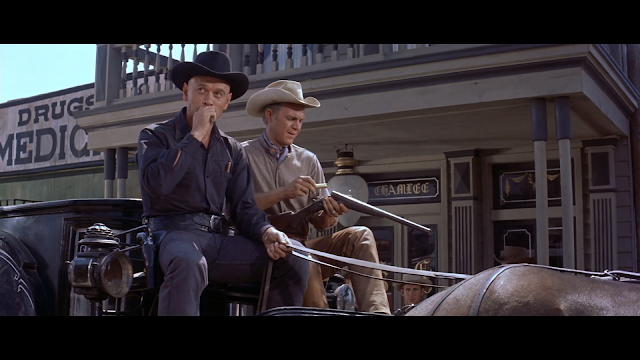Mickey Rooney was a notorious scene-stealer. (I'm going somewhere with this.) He had various ways to snatch the audience's attention away from other actors, often by fiddling with something in his hands. Spencer Tracy was an early victim of Rooney's, and afterward Tracy played the same trick on fellow actors for the rest of his career.
In 1960, Yul Brynner was an established film star. He had won the Oscar for Best Actor in 1957 for his memorable performance in The King and I (1956). Steve McQueen, on the other hand, was a relative upstart, a TV actor, which at that time was lower than a second-class citizen in the acting world.
Despite his TV popularity due to his work on the western Wanted:Dead or Alive!, McQueen was trying as a film actor to live down the infamy of his amateurish performance in the laughable horror movie, The Blob (1958). Nevertheless, using Rooney's and Tracy's tricks, McQueen risked getting fired from The Magnificent Seven by his successful and rather obvious efforts to upstage Brynner at the beginning of this scene—shaking the shotgun shells noisily next to his right ear, one at a time; removing his hat and looking up at the second storeys and rooftops, rotating his head as if scanning while using the hat to shade his eyes. Brynner kept up with McQueen somewhat by taking a cigar out of his pocket, biting the end off, spitting it out, and then lighting the cigar. But he had already lost the audience. All eyes were on McQueen. The two actors did not get along well on set after that.
Unbeknownst to both actors, Brynner's stardom was on the wane in 1960 while McQueen's was on the rise. Indeed, The Magnificent Seven made McQueen a legitimate movie star and the very personification of cool.
🌎🌎🌎
The Magnificent Seven (1960) is John Sturges's homage to Akira Kurosawa's Seven Samurai (1954). [SPOILER ALERT!] In the scene that sets up the story and plot of Kurosawa's classic, an unemployed samurai moseys into a village and learns that a young girl has just been kidnapped and taken into a nearby hut. The men of the village are afraid to intervene because the kidnapper works for a dreaded local warlord whose band of marauders have for years terrorized the village, killing peasants at will, looting their farms, and raping women. The samurai wastes no time in walking into the hut. We hear a brief scuffle, and the samurai walks out of the hut with the girl and no sign of the kidnapper.
[SPOILER ALERT! CONTINUES] I took the above screenshot from the parallel scene in The Magnificent Seven, which sets up a different story but in a similar plot. In an act of racial progressiveness, Chris (Yul Brynner) and Vin (Steve McQueen) volunteer to drive a hearse to Boot Hill carrying the coffin of an Indigenous American. A racist and armed white mob has formed at the cemetery, intending to prevent the Indigenous man's burial there. [END OF SPOILER ALERT!]
This scene is an artistic wonder. The cinematography of Charles Lang shows the effective work of a craftsman keeping it simple and not saying, "Look at me! I'm the cameraman! Look at what I can do!" The actors are comfortable in their characters. The dialogue is brilliant in its economy. The action is telegraphed and, for our purposes, needn't be otherwise. This is one of my favorite scenes in a John Sturges movie.






No comments:
Post a Comment
Remember, a correct guess is just as correct as the titles you're sure of.